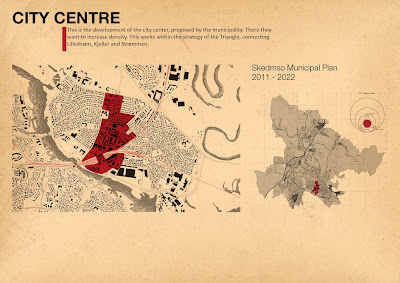This
project is about transforming infrastructure through an investigation of
mobility and streets in cities. The project aimes to provide critical insights
into the conversation about future mobility as well as street quality. It is
easy to argue against the car and the development occurring worldwide, but the
important question is how streets can improve the quality of our life.
The future
holds the possibility to rethink streets and their role. What can the street
perform and how can it interact with its users? Our streets should be safe.
They should also be able to transport more people, collect and treat water in
natural systems, contribute to social interaction and perhaps even provide food?
They are vital in creating healthy sustainable cities. To establish a sense of
connection and respect for your surroundings, speed must also be taken to
consideration. The faster you travel the greater the loss of connection to your
surroundings. When getting inside a car, time and space become distorted. In
terms of mobility, choice must also be offered to people.
Thousands
of zero-emission vehicles are emerging, and it is therefore vital to design
flexible and adaptable streets to gain maximum efficiency. We must prepare our
infrastructure for the future. Can the infrastructure be designed in such a way
that it is capable of having multiple modes of transport interchanging,
possibly changing over time, without losing the quality of the space?
Lillestrøm is in Skedsmo municipality, with 49,000 inhabitants, placed between Oslo City and Gardermoen Airport.
The streets in Lillestrøm are based on a grid system and mostly consits of one family houses with big gardens, carefully marked and closed. The difference between what is privat and what is public in these spaces is clear.
Mapping Lillestrøm
I mapped the width of all streets in Lillestrøm and compared it to other data to try to figure out the logic behind the system. I mapped national roads going through Lillestrøm, speed limit on all streets, traffic volume, parking and open green areas. I discovered that there is no one rule deciding the width of streets in Lillestrøm. Multiple things have to be taken to account. The street width is sometimes related to density, other times to traffic volume as well as speed limit.
Future scenario
Lillestrøm
is a city with grid based street network, and in my project I propose that the
qualities of the grid are maintained and enhanced, with opening up one way
streets and reconnecting cut off ends. That way the full potentials of an open
grid network are exploited. I also propose that most of the streets will be
narrowed, except in the city centre, as a sort of a ‘reverse Haussmann’. To enhance
to quality of the space in the city, the streets are made narrower, and by
doing that I also aim to increase the permeability of the surface as well as increasing
biodiversity. At the same time I develop a typology for shared streets in the
villa neighbourhoods. To spatially connect private gardens to the public street
strengthens the spatial quality as well as safety of both. I propose that the
speed limit for Lillestrøm will reduced down to 30 km per hour and in the villa
neighbourhoods, down to 15 km per hour. This increases the safety enormously
and opens the possibility of intergrating streets better into other spaces in
the city. Driving from one end of Lillestøm to another, at this reduced speed
limit is only increased by 4 minutes from todays situation.
Redesigning the Streetscape
Finally I propose the city centre expansion and future densification to follow Alexander Kiellands gate - a big and beautiful esplanade that goes from existing city centre, capable of supporting much higher density than today’s situation. The esplanade is well suited for the new tram line I propose, to connect the scattered development in the municipality. That tram line then has the possibility to connect to Oslos Metro system, addressing the problem of commuter traffic in the municipality.
To go in this direction could take us down a safer,
healthier and more efficient path, towards sustainbility, and would develop a new image of Lillestrøm
as a more livable city, with a much greater potential to meet tomorrows
challenges when it comes to transport.
Sigurborg Ósk Haraldsdóttir, Autumn 2011





































